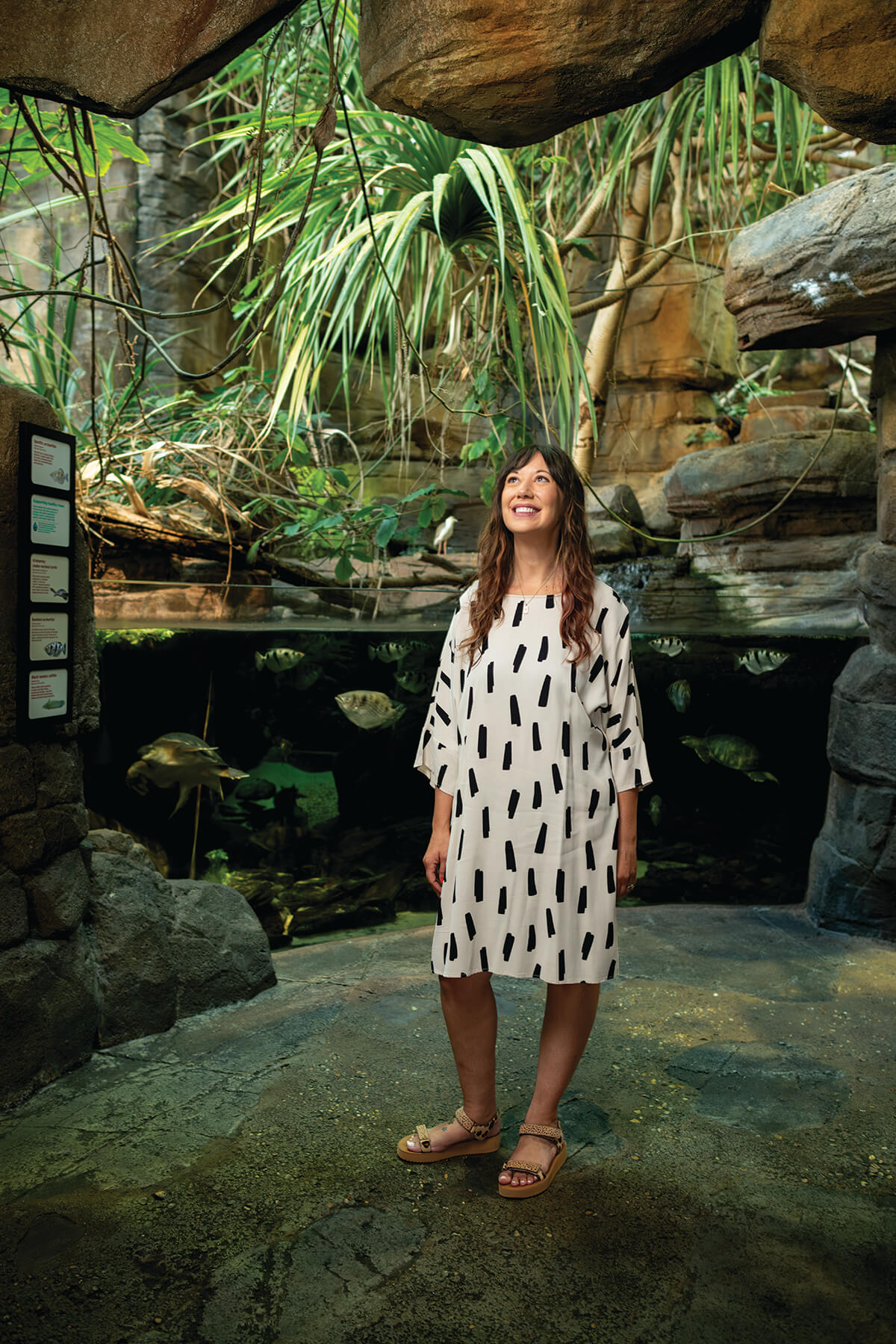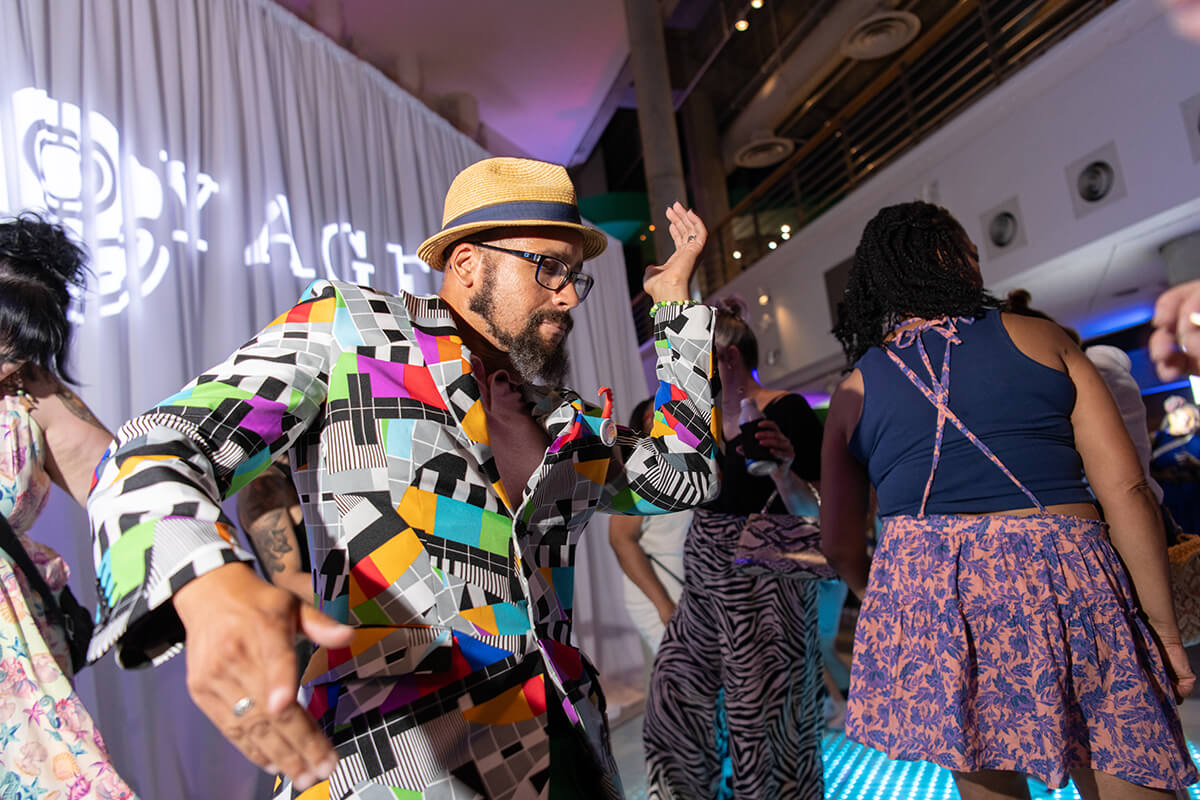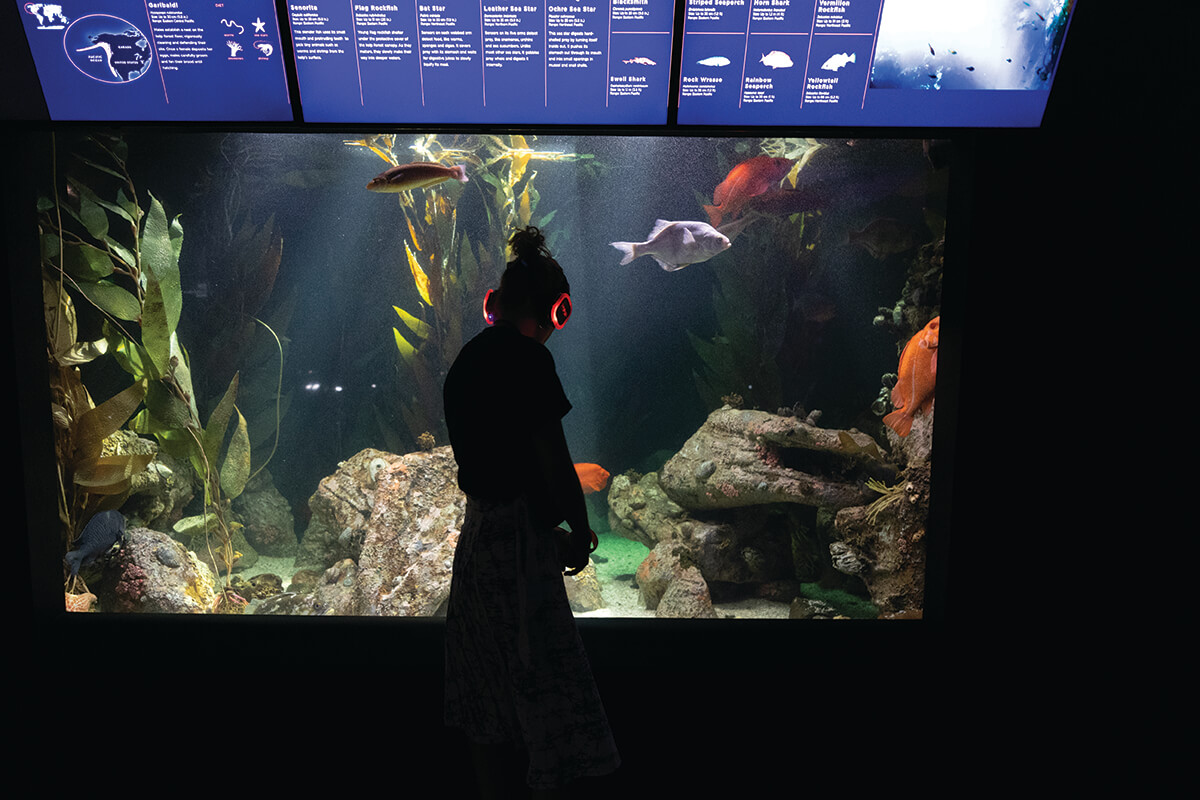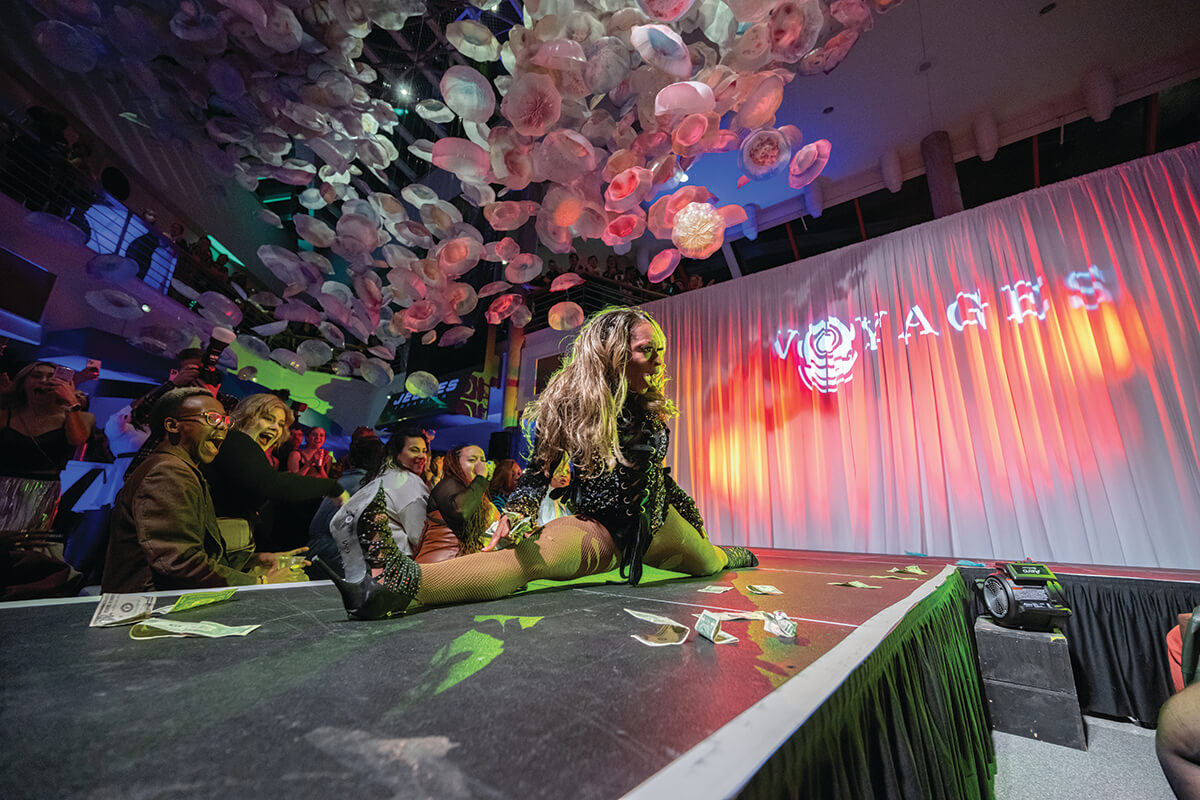Arts & Culture
National Aquarium’s Voyages Program Sparks Wonder in Adults
Fusing art and science, Jenny Hamilton has brought a program built by Baltimore, for Baltimore to the Inner Harbor institution.

It’s the kind of brutally hot August day that pushes everyone inside, and the National Aquarium is buzzing.
Jenny Hamilton is perched on a bench in front of the Black Tip Reef underwater viewing area, feeling giddy at the overflowing energy and excitement. It’s almost hard to hear her, as campers and vacationers exit Shark Alley and noisily descend on the 27-foot viewing window that curves four feet around the underwater reef teeming with animals, from angelfish to whiptail rays.
That’s the easy part—attracting kids, school groups, and families to ooh and ahh over the sea creatures. But the more recent challenge for Hamilton, the Director of Community Partnership Strategy, has been to encourage adults to see the Inner Harbor’s iconic structure as theirs, too. To do that, she knew she would need to create a range of projects that would draw a diverse audience reflective of the city the Aquarium was created in.
To say Hamilton was successful oversimplifies the Aquarium’s flourishing Voyages program, which launches its sixth installment next month. The ongoing immersive series for adults encourages a connection between art and science, while simultaneously celebrating all things Baltimore. Artists are asked to explore a question around conservation and then create a one-night-only experience for attendees.

“The pandemic served as a natural inflection point for the Aquarium to reexamine its programs,” says Margot Amelia, the National Aquarium’s executive vice president. “How can we achieve our mission to connect people with nature, to inspire care and compassion of our ocean planet, if we don’t get new audiences like local adults to engage with us? To feel as though the Aquarium is for them?”
One part of that was building on the foundation of an already popular spot (they have an annual attendance of 1.5 million visitors and are the state’s largest tourism attraction) and the other was figuring out who isn’t visiting and why.
“I’ve always been interested in what motivates people’s behavior,” says Hamilton, who majored in psychology at Mary Washington College in Fredericksburg, VA. That included how people function within different community organizations.
After graduation, Hamilton took time off before graduate school and followed friends to Baltimore for what she assumed would be a brief stint. “Even though it’s been over 20 years, I still feel like I can’t quite call myself a Baltimorean,” she says. But she soon fell in love with the city. Before she knew it, five years had passed and, after working in hospitality, she realized her strengths lay in managing complex, large-scale operations—all of which led her to land a position on the National Aquarium’s operations team in 2006.
Hamilton, who was born two years before the Aquarium opened in 1981, worked in guest operations—managing front-of-house and coordinating disability access services. Through the latter, she developed a “deep understanding about barriers and accessibility” for the disability community, which then led her to wonder how to reach other marginalized, underserved communities.
Her role at the Aquarium soon morphed into creating community engagement strategies to draw local residents, many living only miles away. And not just adults, but kids who found the Aquarium prohibitively expensive or simply thought it wasn’t a space for them.
The Aquarium also wanted to make sure that conversations around Diversity, Equity, Inclusion, and Justice (DEIJ) weren’t just abstract ideas. The question they asked, says Hamilton, was: “How can this be [incorporated] into everything we do and be a part of our identity?”
During Hamilton’s tenure, she started the Read to Reef program in partnership with the Enoch Pratt Free Library, offering Baltimore City kids who read five aquatic or conservation-themed books, four free tickets to the Aquarium. (They’ve given out more than 77,000 free tickets since 2015.)
“I like to think of myself as a professional cat herder. Like, how can I facilitate really equitable, large-scale collaborations so that the end result isn’t just one person, one face, one ego,” she says.
She pauses for a second as a crowd of kids shuffles into the exhibit.
“Someone recently said, ‘Oh, I heard you were the brain behind Voyages.’” She bristles at that assumption because there were so many hands that went into its development, from brainstorming to execution. “My least favorite phase is ‘build it and they will come.’ You have to listen. You have to collaborate,” she says.
“VOYAGES GAVE ME A CHANCE TO RE-ENVISION THAT THE AQUARIUM COULD BE A PLACE FOR ME.”
How Voyages came to be is the ultimate lesson in collaboration. More than 25 years ago, the National Aquarium received a generous endowment from Marjorie Lynn Bank to fund a lecture series. The talks were well-received, but the audience had waned, and they weren’t attracting anyone new to the building. Was there a potential to engage an audience in a different way, the Aquarium staff wondered.
The Aquarium leadership—including president and CEO John Racanelli—gave Hamilton and her team permission to explore more creative uses that would still fulfill the intent of the gift. That this was taking place in 2020 and 2021—with the pandemic in the headlines alongside racial reckoning and environmental justice—really helped shape the conversation But since they still weren’t sure what they were creating,
“We kept calling it the ‘Period of the New Thing,’” Hamilton says, laughing.
They gathered staff members with a wide range of expertise (operations, education, communication, science) but also those who had strong relationships with different areas in the city but had “never been given permission at work to say, ‘Can I build something for my people? What if I create a space for them?’” Hamilton explains.
Hamilton and her team also started going to coffee with different community members and leaders, eventually creating what she called her community advisory group.
“Something that makes me love this place so much is that it’s a city where people want to contribute, not just consume,” says Hamilton. “And it’s so collaborative—it has a DIY ethos to it.”
The idea that finally stuck—Voyages—seemed so simple. Produce a night—created by the richly talented artistic community in Baltimore—where adults can wander around, local beer in hand, and feel some wonder in a space that is always packed wall-to-wall with kids.
“As a woman who just turned 40 with no kids, I often view aquariums as family-friendly experiences,” says Liz Miller, a Baltimore County Public School art teacher and owner of Mural Art Tours Baltimore. “I do visit museums, but the Aquarium has always felt like a place that you take children,” she says. “Voyages gave me a chance to re-envision that the Aquarium could be a place for me as well.”
Now Miller has been to almost all the programs. “What Voyages does is connect the arts to science in new and innovative ways,” she says. “It trusts the scholarly mind of the artist to approach the topic of biology and be the connection to a broader audience. These experiences help the audience experience the Aquarium in a brand-new way.”
For each artist, it starts with a trip to the Aquarium to get the creative and intellectual juices flowing. “They get a membership so they can independently come talk to our staff and just sit and watch and think and dream and read all the information,” says Hamilton.
Then they come up with an artist’s statement and begin a deeper dive (so to speak). Hamilton explains that the artists always meet one-on-one with Jack Cover, the general curator—“they get to see the Aquarium through his eyes”—before being matched with other experts, whether locally or throughout the country. All of the work is tied in some way to the Aquarium’s mission.
Voyages: Chapter 1 launched in July 2022, when guests were invited to embark on an audio-focused tour of the Aquarium’s exhibits while listening to an original soundscape composed by local beatboxer, vocal percussionist, and breath artist Shodekeh. The audio was inspired by Shodekeh’s research exploring animal communication. To facilitate his research, Shodekeh was put in touch with the K. Lisa Yang Center for Conservation Bioacoustics at the Cornell Lab. (For each Voyages, Hamilton and Sarah Doccolo, community programs manager, do their own research to pair the artist with just the right sources.)
And while in the past someone from the Center for Conservation Bioacoustics at the Cornell Lab might have been flown in to present a lecture, now they are being used to create a bigger, more meaningful, often interactive project. The artists are interviewing them, asking questions, consolidating all the information, and then using that as inspiration to go out and produce work.
Thanks to the Bank endowment, the artists are able to create a team—for Shodekeh that meant visual artist Erica Hansen and audio engineer Eric Spangler—to install a one-of-a-kind art experience.
“Voyages proves that taking on this level of risk can make magic,” says Ashley Molese, who has been a curator and cultural producer for 15 years and is part of the community advisory group. “I’ve never seen anything like this done before. To me, it’s a love letter more than anything else. Baltimore is full of people who just want to pour more love into the city, and it feels like for two nights a year, Voyages gets as many of us together in one room to do just that.”

Each subsequent chapter has brought about the perfect marriage of visualization and representation. At Voyages: Chapter 2, experimental electronic musicians Jessica Keyes and Patrick McMinn “wanted to study all of the communities across species that need to come together to create something like the Bay,” says Hamilton.
All these things need to work together to be successful, much like creating music. They visited Horn Point Oyster Hatchery on the Eastern Shore—and “so we’re out there with these musicians, and seeing oysters spawn in front of us, and seeing these big vats, and they’re talking to the ecologists and they’re asking questions that the ecologist was like, ‘Those are really good questions,’” Hamilton recalls.
It is a mutual admiration between artist and scientist she sees with almost every collaboration. The scientists quickly realize, “Oh, these people are just as nerdy about that stuff as I am,” says Hamilton. “They’re just coming at it from a different angle, but at the end of the day, we both are just curious about why the world is how it is.”
And often the artist will ask questions that gives the scientist a whole new perspective on their own work. Hamilton has seen a researcher say, “‘I actually might need to go run a seminar on that next year and explore it.’ It’s really beautiful.”
Voyages: Chapter 4 featured drag artist Devon Vaow (also known as Evon Dior Michelle) focusing on adaptation. His conclusion: “Every organism on the planet has to adapt.” And so that night he used drag techniques to illustrate adaptations and to highlight the skill, craft, and beauty of drag.
For Vaow, the experience was much more than a one-off. During the months from inception to execution, the Aquarium staff kept checking in with him to ensure that his “comfort as an LGBTQ+ community member was met,” he says. They even hired inclusion and diversity specialist Jabari Lyles to come in and educate the National Aquarium staff “on the LGBTQ+ community, and inclusive language and verbiage.” It made him feel like they weren’t just checking boxes on a diversity initiative, but really wanted to learn from the relationship.

It was mutual. “Having artist-focused programming like this creates not only a sense of intersectionality within the Baltimore community, but also sends a strong message that art is universal in all of its forms,” says Vaow. “I’m proud to say that Chapter 4 was the fastest-selling chapter they’ve had, which shows how much support our [drag] community has in Baltimore.”
That’s verifiable—and according to a quick search on Google, so is this: “I’m the first drag queen in history to have an aquarium-sanctioned drag show,” Vaow says proudly. “In today’s political climate, furthermore, it solidifies that queer artists have a place in major institutions.”
Amelia, the National Aquarium’s executive vice president, always stations herself just inside the door as Voyages attendees arrive. She’ll do it again come November, when recording artist and performer Dan Deacon will take over.
“These are not our typical daytime guests,” she says. “I smile so hard it hurts.”
For Amelia, the thrill is seeing a new crop of adults all of a sudden feel included in a way they didn’t before—buying a $60 ticket, dressing up, and responding to a program that was a risk for the Aquarium.
“What I love is that never in a million years would I have developed a program like this,” says Amelia, recognizing that the establishment needed a fresh idea. “This ‘new thing’ gives me hope for the continued relevance for the next 43 years.”
Miller agrees. “The National Aquarium is doing something that I haven’t really seen done well by other institutions—it’s allowing the public to engage with an institution in a way that is education cloaked as entertainment. To this day, I’ll never forget that Pattiegonia, a conservationist drag queen, taught me that clownfish are trans.”
For Hamilton, seeing each Voyages chapter come to fruition and find success feels good.
“This is really, really validating,” she says. “Seventeen years of philosophies of how I think cultural organizations should be community-oriented—and it seems to be working.”